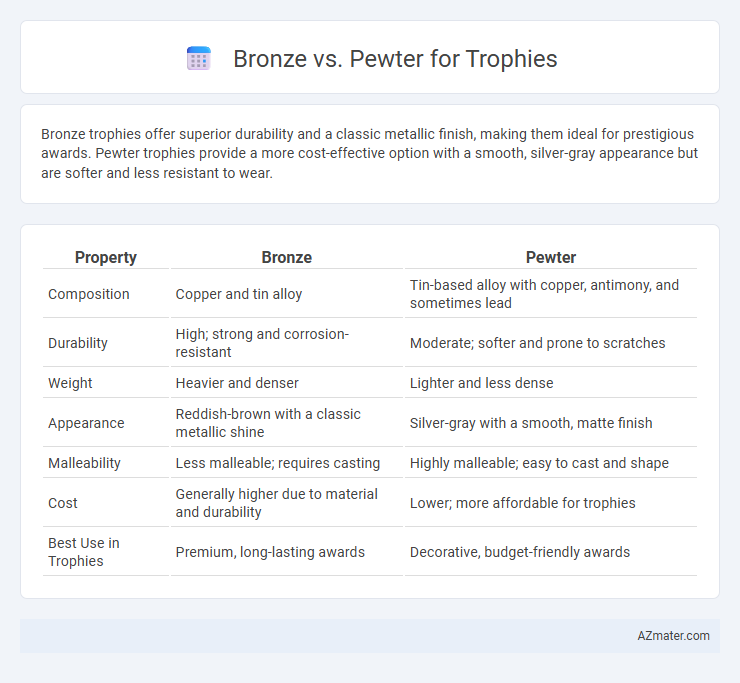Bronze trophies offer superior durability and a classic metallic finish, making them ideal for prestigious awards. Pewter trophies provide a more cost-effective option with a smooth, silver-gray appearance but are softer and less resistant to wear.
Table of Comparison
| Property | Bronze | Pewter |
|---|---|---|
| Composition | Copper and tin alloy | Tin-based alloy with copper, antimony, and sometimes lead |
| Durability | High; strong and corrosion-resistant | Moderate; softer and prone to scratches |
| Weight | Heavier and denser | Lighter and less dense |
| Appearance | Reddish-brown with a classic metallic shine | Silver-gray with a smooth, matte finish |
| Malleability | Less malleable; requires casting | Highly malleable; easy to cast and shape |
| Cost | Generally higher due to material and durability | Lower; more affordable for trophies |
| Best Use in Trophies | Premium, long-lasting awards | Decorative, budget-friendly awards |
Introduction to Bronze and Pewter Trophies
Bronze trophies are celebrated for their durability, classic metallic luster, and resistance to corrosion, making them ideal for long-lasting awards. Pewter trophies, composed primarily of tin alloy, offer a unique, silky-gray finish that can be easily molded into intricate designs for customized accolades. Both materials provide distinctive aesthetic and functional benefits, with bronze emphasizing tradition and robustness, while pewter highlights versatility and detailed craftsmanship.
Composition and Properties of Bronze
Bronze, primarily composed of copper and tin, offers exceptional durability and corrosion resistance, making it ideal for long-lasting trophies. Its higher tensile strength compared to pewter ensures better resilience against wear and deformation. The alloy's distinctive reddish-brown hue also provides an elegant and classic appearance preferred in prestigious awards.
Composition and Properties of Pewter
Pewter is primarily composed of tin (85-99%) with small amounts of copper, antimony, bismuth, and sometimes lead, providing a softer and more malleable material compared to bronze, which mainly consists of copper and tin. Its low melting point around 170-230degC allows for intricate casting, making pewter ideal for detailed trophy designs. Pewter's duller luster and lower hardness result in less durability than bronze but offer a unique aesthetic suitable for decorative awards.
Visual Appeal: Bronze vs Pewter
Bronze trophies exhibit a rich, warm patina with deep reddish-brown tones that enhance their classic and prestigious visual appeal. Pewter trophies offer a cooler, silvery-gray finish with a smooth, matte surface that lends a modern and understated elegance. The choice between bronze and pewter depends on whether a timeless, traditional look or a contemporary, subtle aesthetic is desired for the trophy.
Durability and Longevity Comparison
Bronze trophies exhibit superior durability due to their high resistance to corrosion and wear, making them ideal for long-term display. Pewter, while lighter and more affordable, is softer and prone to scratches and dents, which can compromise its appearance over time. For trophies intended to last generations, bronze offers enhanced longevity and maintains its aesthetic appeal under various environmental conditions.
Cost Differences: Bronze vs Pewter Trophies
Bronze trophies typically cost more than pewter trophies due to the higher price of raw materials and the more labor-intensive casting process involved in bronze production. Pewter, an alloy primarily composed of tin, offers a more affordable alternative with lower material costs and simpler manufacturing methods, making it ideal for budget-conscious events. While bronze provides greater durability and a classic metallic finish, pewter trophies strike a balance between cost-efficiency and aesthetic appeal.
Customization and Engraving Options
Bronze trophies offer deep engraving capabilities with fine detail retention, making them ideal for personalized messages and intricate designs. Pewter, being softer, allows for versatile customization through casting and embossing but may have less precise engraving quality compared to bronze. Both materials support varied finishes and plating, enabling tailored aesthetic choices for unique, high-quality trophy presentations.
Maintenance and Care Requirements
Bronze trophies require regular polishing with a soft cloth and occasional application of a wax-based protectant to prevent tarnish and maintain their luster. Pewter trophies need gentle cleaning with mild soap and water, avoiding abrasive materials to prevent scratching, as they develop a natural patina over time that many collectors appreciate. Proper storage away from excessive moisture and direct sunlight helps preserve the finish and extends the life of both bronze and pewter awards.
Environmental Impact and Sustainability
Bronze trophies, typically composed of copper and tin, offer higher recyclability and longer durability compared to pewter, which is primarily a tin alloy with smaller amounts of copper and antimony, potentially raising environmental concerns during extraction and disposal. Pewter production generally involves lower energy consumption and emits fewer greenhouse gases, yet it may contain trace amounts of harmful metals that can affect soil and water quality when discarded improperly. Opting for recycled bronze materials significantly reduces mining impacts and supports a circular economy, making bronze a more sustainable choice for eco-conscious trophy manufacturing.
Choosing the Right Material for Your Trophy
Bronze offers exceptional durability and a classic, prestigious appearance, making it ideal for high-end trophies that symbolize long-lasting achievement. Pewter provides a more affordable yet elegant option with its smooth, silvery-gray finish, suitable for mid-range awards without compromising on style. Selecting between bronze and pewter depends on budget constraints, desired weight, and the level of prestige associated with the trophy.

Infographic: Bronze vs Pewter for Trophy
 azmater.com
azmater.com